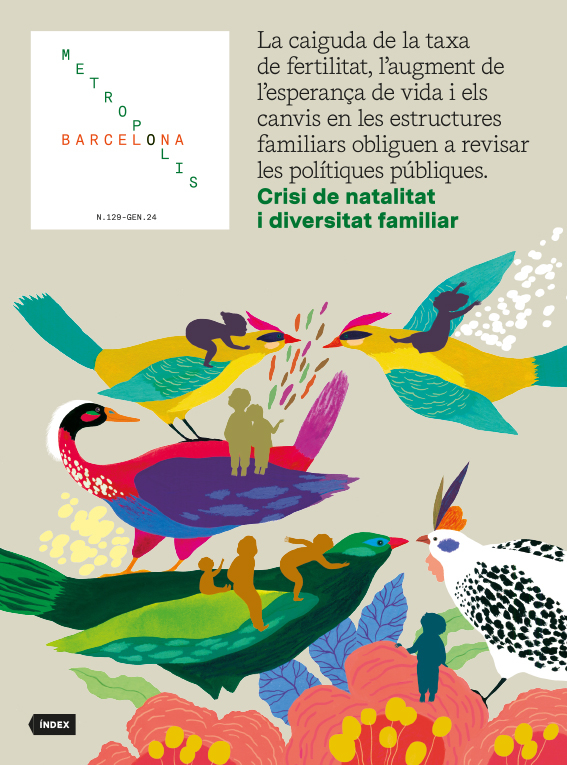The birth rate crisis and its demographic impact on the Barcelona metropolitan area
Birth rate crisis and family diversity
- Dossier
- Jan 24
- 11 mins
The population pyramid of the metropolitan area of Barcelona is not inverted, and the ageing population does not lead us to collapse, as is often believed. Over the past decades, there have been peaks of major demographic vitality, but also birth rate crises closely tied to economic recessions. The most numerous generation, boomers, is around 45 years old.
An ageing territory?
Almost five million inhabitants call the metropolitan region of Barcelona home. Its dynamics defy a strictly linear narrative; instead, they unfold cyclically. Contrary to the notion of an inverted pyramid (see Figure 1), suggesting that ageing inevitably leads to decline, this is not the case. However, numerous anomalies warrant analysis from a demographic perspective to delve into the heart of the matter. Consequently, we can see fluctuating patterns, marked by peaks that indicate significant demographic vitality, and interspersed with valleys of population scarcity. We must bear in mind that the pyramid offers insights accumulated over more than a century of experience, contributing depth to our understanding!
The metropolitan area of Barcelona has never witnessed such a sizeable and healthy adult population. The alarmism over the decline in birth rates is therefore surprising.
The most sizable cohort, born in 1976 at the pinnacle of the baby boom, is now 46 years old as of 2022. It’s worth noting that the concentration of this significant generation wasn’t a fleeting occurrence; instead, it’s been a protracted phenomenon encompassing individuals currently aged between 39 and 56. This group, comprising just under 1.4 million adults, which represents almost 30% of the resident population in the metropolitan area of Barcelona, were born between 1966 and 1983. Since their birth and, we hope, for many years to come, they have been and will continue to be the most numerous generations in this territory. This presents an opportunity for both the present and the future, as the metropolitan area of Barcelona has never witnessed such a sizeable and healthy adult population. As a result, the persistent concern about the perceived lack of replacement, a prediction doomsayers make whenever birth rates decline, never ceases to amaze us.
We must debunk the notion that immigration serves to offset the declining birth rates in the country. Take, for example, the metropolitan area of Barcelona, where over a quarter of the most populous generations were born outside of Spain. In contrast, most individuals aged over 70 were born in other regions of Spain, outside of Catalonia.
Furthermore, we must consider that around the cohort of 2011 (aged between 7 and 16 in the latest census), another population concentration becomes evident, prompting us to ask ourselves whether the so-called birth rate crisis began just a short time ago.
The question posed at the beginning of this section must be answered accordingly: the metropolitan region of Barcelona does not exhibit an aged demographic structure. Instead, it is characterised by a substantial population of baby boomers, currently around 45 years of age, with an average life expectancy of an additional 41.5 years for men and 46.7 years for women. These generations are, and will continue to be, the most numerous in the region throughout their lifetimes, both now and in the coming half-century, irrespective of fluctuations in natality. Notably, since the onset of the 21st century, before the onset of COVID, life expectancy in Catalonia had increased by four years for men and three years for women among individuals aged 45.
 Figure 1. Population Pyramid of the Metropolitan Area, 2022. Source: Compiled using figures from the Statistical Institute of Catalonia (Idescat).
Figure 1. Population Pyramid of the Metropolitan Area, 2022. Source: Compiled using figures from the Statistical Institute of Catalonia (Idescat).Are we experiencing growth or decline?
Population growth in the metropolitan area during the last two decades of the 20th century was virtually non-existent, a result of a convergence of factors, including declining birth rates, relatively stable mortality (natural or vegetative growth) and a balanced migratory pattern – where the number of people leaving the metropolitan area roughly equalled those arriving (see Figure 2).
In essence, demographic dynamics exhibited sluggishness during the turn of the century, marked by an economic crisis that the Barcelona Olympic Games failed to mitigate. Suddenly, coinciding with the dawn of the new century, between a remarkable economic upturn since 2000 and the onset of the “Great Recession” in 2009, significant demographic growth emerged. This was the result of a rise in birth rates, notably propelled by a markedly positive migratory balance: more births were taking place, and the influx of people far exceeded those departing. Here, we find a clue to the factors influencing demographic evolution – a pace shaped by the economic circumstances of each period.
Today, we find ourselves back at a zero-growth level, an unstable equilibrium that could be disrupted at any moment.
Certainly, the growth rate for the biennium 2012-13 was negative, attributed not to natural factors but to migration: more people were leaving than arriving to reside here. Since the 2009 crisis, the natural growth rate in the metropolitan area has consistently fallen, hitting zero growth (with equal birth and death rates) in 2018 and turning negative in 2020 due to the mortality caused by the COVID pandemic. However, growth rates seem to be rebounding; today, we find ourselves back at a zero-growth level – an unstable equilibrium that could be disrupted at any moment.
 Figure 2. Demographic Growth Rates in the Metropolitan Area. Source: Compiled using figures from the Statistical Institute of Catalonia (Idescat).
Figure 2. Demographic Growth Rates in the Metropolitan Area. Source: Compiled using figures from the Statistical Institute of Catalonia (Idescat).Indeed, as the 20th century drew to a close, natural growth played a pivotal role in warding off five-year spans of migratory decline (1981-85 and 1991-95). However, in the 21st century, migration has taken centre stage, showing a remarkable surge from 2000 to 2008 and a resurgence between 2014 and 2019 that was abruptly halted by the pandemic.
At present, 62% of the metropolitan area’s population was born in Catalonia, while 22% hails from outside of Spain, and 17% from the rest of Spain. The average age of the latter group is 67 years, indicating their arrival in the metropolitan region of Barcelona quite some time ago. In contrast, the average age of the other two groups is 39 years.
Are we poised for growth or decline? Right now, the outlook hinges on the region’s migratory balance, given that the rate of natural growth (births minus deaths) stands at zero, though not in the negative.
Is there a birth rate crisis?
I want to make it clear that we are not shirking responsibility. Our focus is squarely on addressing the birth rate crisis in the metropolitan area, employing specific indicators to measure this phenomenon (see Figure 3). This includes assessing the fertility rate (number of children per woman), tracing its timeline through the average age of motherhood, and, more precisely, understanding the age at which a woman becomes a mother for the first time. It’s crucial not to overlook the fact that provisional figures for 2022 suggests the metropolitan area has hit a nadir in fertility, with 1.1 children per woman – a figure similar to that of 1995.
This birth rate crisis unfolds within a broader timeframe, beginning in the mid-1970s and navigating through noteworthy fluctuations worth examining. During that period, the fertility rate stood at nearly three children per woman, marking the youngest timeline on record: 25.5 years for the first pregnancy. In response to the economic downturn triggered by escalating oil prices and a surge in unemployment rates, significantly impacting an industrially concentrated region like the metropolitan area of Barcelona, fertility indicators witnessed a decline. In the early 1980s, they dwindled to 1.7 children per woman, with an average age of 28.1 years, and by the mid-nineties, they plummeted to slightly over 1 child per woman, with an average age of over 30.
To establish benchmarks for comparing these values, and recognising that children are usually born to couples, the population replacement level is set at 2.1 children per woman. It’s crucial to highlight that female fertility starts to decline exponentially after the age of 30.
The economic (and birth rate) crisis lasted until the close of the 20th century. However, from this point onward, there was a resurgence in the fertility rate, peaking at 1.5 children per woman in 2008. Simultaneously, the age at which women became mothers stabilised, holding consistently at 30 years for the firstborn and 31 for general motherhood.
The decline in fertility has been accompanied by an unprecedented delay in the timeline: the average age of motherhood has surpassed 33 years.
It must be made clear that the upward trend was disrupted with the onset of the last major economic recession in late 2008, and there has been no cultural or demographic shift in the metropolitan area. Furthermore, the decline in fertility has been accompanied by an unprecedented delay in the timeline: the average age of motherhood has surpassed 33 years.
What significant differences exist between the crisis period of 1981-1995 and the ongoing one that began in 2009, with indications suggesting it has not yet concluded? First and foremost, we observe changing institutional patterns of fertility: the proportion of children born to married couples, which was almost 90% in 1995, fell to 65% at the peak of the recovery in 2008 and currently stands at 50%. This is because the other half is born outside of marriage, though not outside of a committed partnership.
However, beyond these cultural shifts, it is worth mentioning the current economic outlook. Towards the end of the year 2000, the economic recovery was remarkable, accompanied by an unprecedented rise in the population of non-Spanish nationals due to improvements in the job market. However, current expectations for a recurrence of such an exceptional situation are low. All signs point to challenging times for natality, particularly in the short to medium term, as European incentives and the extraordinary job protection measures introduced during the pandemic (such as temporary layoff schemes, ERTE) are withdrawn.
 Figure 3. Fertility Rate and Timeline in the Metropolitan Territory. Source: Compiled using figures from the Statistical Institute of Catalonia (Idescat).
Figure 3. Fertility Rate and Timeline in the Metropolitan Territory. Source: Compiled using figures from the Statistical Institute of Catalonia (Idescat).To end on a positive note, I am pleased to share the projections made by the National Institute of Statistics (INE) concerning the number of births in the province of Barcelona, looking ahead to the year 2036. Although estimates for 2022 indicate a level similar to the mid-1990s (just over 40,000 births), the INE foresees a gradual increase from 2023 onwards, reaching 55,000 births by the end of the projected period.
The newsletter
Subscribe to our newsletter to keep up to date with Barcelona Metròpolis' new developments




